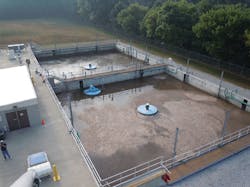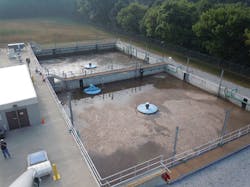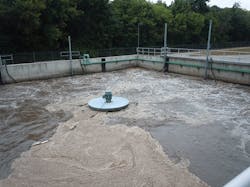WCCD Increases Treatment Capacity in a Small Footprint
The West Central Conservancy District (WCCD), located in Hendricks County, Ind., was established in 1992 and comprises five geographical areas. The district was formed to resolve sewer issues that the service area was experiencing with the local utilities company in the mid-1980s. The utilities company was no longer able to meet the requirements for its wastewater treatment operations set by the Indiana Department of Environmental Management.
In 1990, local developers formed a committee and decided to run sewer lines from their residential developments to the utilities plant at their own expense in order to ensure success of their properties. The developers purchased the utilities company to ultimately form the new district treatment facility in 1992.
The district started out with less than 100 customers but experienced rapid growth in the area, resulting in several plant upgrades. In 1995 the plant expanded from 500,000 gallons per day (GPD) to 900,000 GPD and by 1999 served approximately 2,000 customers. To keep pace with the area’s growth, WCCD expanded again in 1999 to a 2.4 million-gallon-per-day (MGD) plant and again in 2005 with an increased capacity of 5.0 MGD. By 2011, the district was serving a customer base of 8,000. In addition to residential customers, it also has 119 commercial users and one industrial user.
The 2005 expansion included the installation of a four-basin AquaSBR® system, which has the capability to treat a much larger capacity in a small footprint on the available land space. WCCD chose the AquaSBR system not only for its treatment capacity in a small footprint but also for its outstanding performance.
The plant’s only challenges have been with influent grease from several area restaurants and high-strength waste from a large bakery. To resolve the issue, WCCD increased inspection of the restaurants’ grease traps and drains, and enforced pretreatment ordinances. The plant also closely monitors the biomass rate, keeping it significantly low to produce the highest quality effluent during higher loadings from the restaurants.
Aquasbr System Process
The AquaSBR system operates on a simple concept of introducing a quantity of waste to a reactor, treating the waste in an adequate time period, and subsequently discharging a volume of effluent plus waste sludge that is equal to the original volume of waste introduced to the reactor. This “Fill and Draw” principle of operation involves five basic steps: Fill, React, Settle, Decant, and Sludge Waste. The system may be designed to include seven individual phases of operation but the inclusion or duration of any individual phase is based upon specific waste characteristics and effluent objectives.
Where nutrient removal is required, a simple adjustment to the SBR’s operating strategies permits nitrification, denitrification, and biological phosphorus removal. Optimum performance is attained when two or more reactors are utilized in a predetermined sequence of operation.
Design Characteristics
Flow from WCCD’s screening process is split into two separate biological treatment trains. The four-basin AquaSBR system functions as the “West Train” with a capacity of 3.5 MGD. Effluent from the SBR is sent through a separate ultraviolet (UV) light disinfection system, then recombines with the “East Train” effluent. Due to the high dissolved oxygen permit of 5 mg/L (winter) and 6 mg/L (summer), the combined flow is then directed to re-aeration prior to final discharge into White Lick Creek.
Operator Training
Aqua-Aerobic Systems provides on-site operator training as part of its Customer Service offerings. WCCD requests the training annually to keep its operations staff current on new or cost-effective ways to optimize treatment and troubleshoot any issues.
For more information about Aqua-Aerobic’s AquaSBR system, visit www.aqua-aerobic.com.
A cable-moored AquaDDM® Direct-Drive Mixer combined with fine-bubble aeration is operating in one of the plant’s AquaSBR basins.


